
fanfoy
HalfDork
8/26/13 1:54 p.m.
I just brought back the foundation for my new project. This the complete running gear from a 1930 Plymouth 30U. Since apparently Woody won't make his speedster into a boat-tail, well this will be a boat-tail.

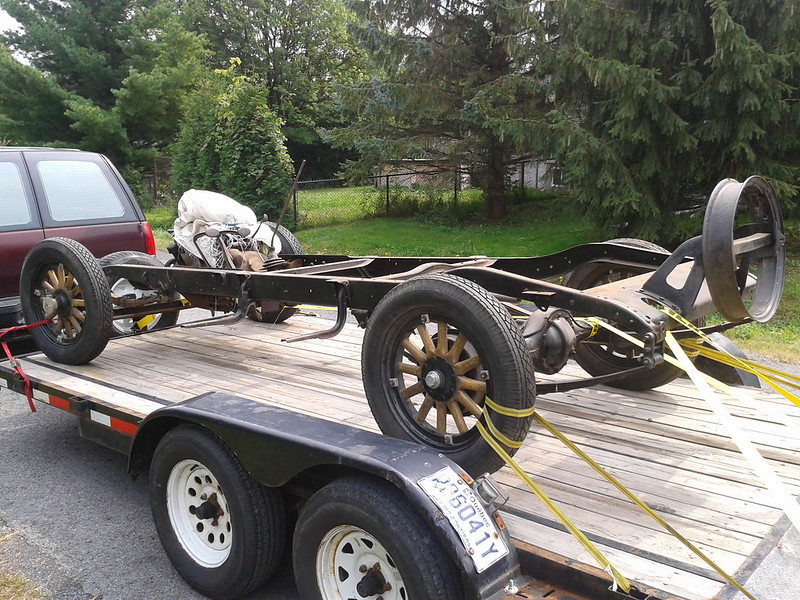
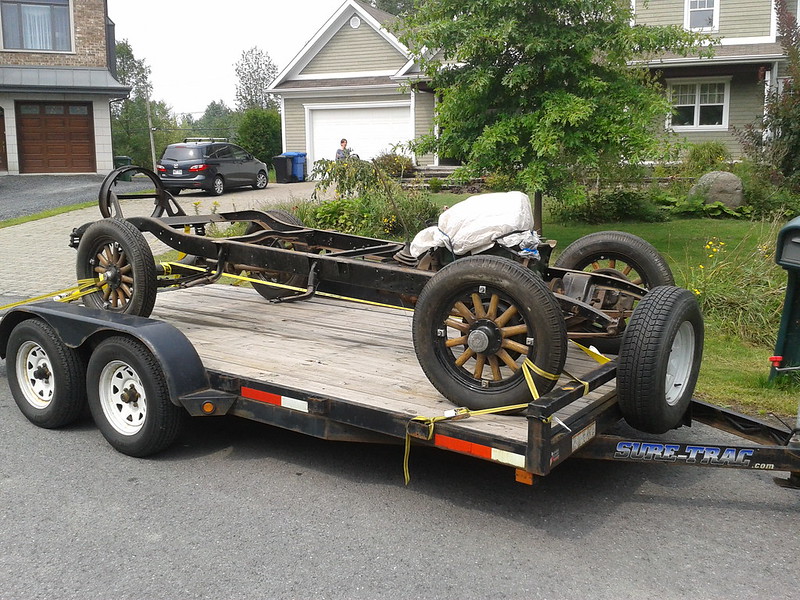
I paid the princely sum of 450$ for what is shown plus two boxes full of misc parts from it. I really wanted a Mopar because these came with a lot of luxurious features like four-wheel hydraulic brakes, hydraulic shocks, water pump, full pressure oil system and gas pump. Also, this has the Mopar flathead four which is a very sturdy engine (with hardened valve seats) based on the no-less sturdy flathead six.
The plan is to keep the mechanical aspect pretty standard. The wooden wheels will get replaced by some wire wheels. The engine will get a refresh, a bump in compression and something sportier for carbs and exhaust. The body will have a lowered steel floor (so the seats will be between the rails). The rest of the body will be built old-school with an aluminum body stretched over an ash frame.
First order of business is to disassemble everything to assess everything. One thing I do know is that I need to un-seize the engine. What is everyone's favorite method?
Acetone and Dexron II 50/50 mix. Awesome find, I like where this is going
Engine unseizing, buy a gallon of PB blaster, pour like a cup down each bore, screw the plugs in loosely(to prevent evaporation) wait a week. Then use a wrench to rock it back and forth with the plugs out. Dont use more than maybe 100 ft lbs. Just keep soaking it in PB till it comes loose.
You're already farther along than Woody! 
I approve of this project!
I'd love to make ours a boat tail, but alas, time will not allow...

fanfoy
HalfDork
8/27/13 11:02 a.m.
Started to tear up into what I have. I started by opening the engine to see how it looked inside:
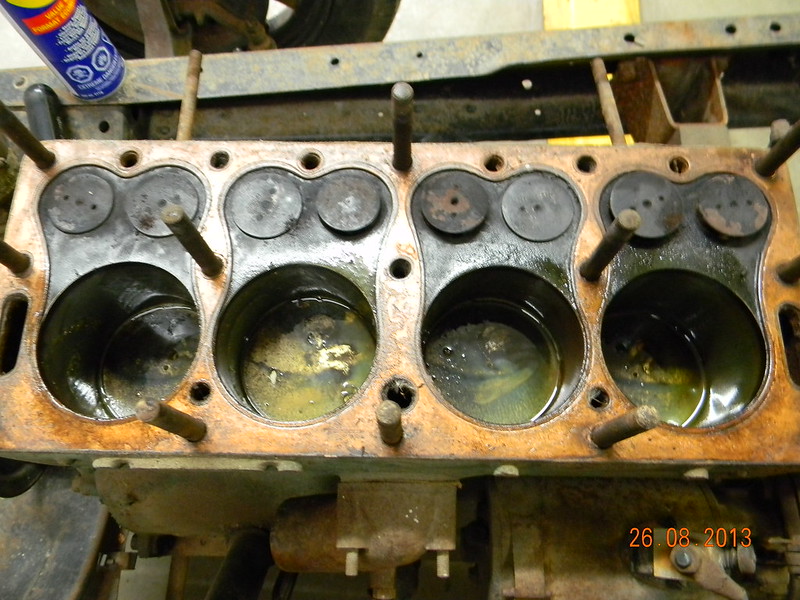
The good: cylinder walls are absolutely perfect, the insides don't look too bad and I haven't found any broken studs stuck in the block.
The bad: this is apparently one of the last models build before they were equipped with a water pump, and I seem to be missing some stuff (like the carb, and the strap that holds the generator)
Also started to disassemble the frame. Again, one or two things missing but nothing big.
So I guess I'll have to decide if I want to keep the engine, or go with something else.
Anyone have any ideas for an independent water pump that looks vintage correct?
Perhaps an aftermarket water pump sold for the Ford model T could be adapted?
Quick update:
Finished disassembling the frame. It went surprisingly well. Only broke two bolts and had to cut one. The parts take very little room when they are all off the frame.
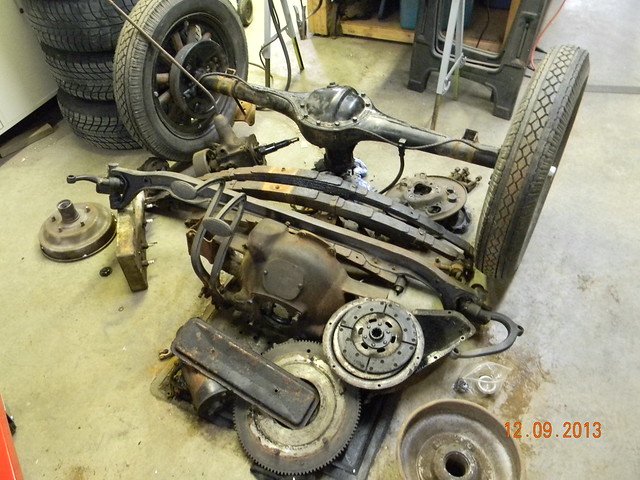
I also kept investigating the engine and this is what I found.

I'm not sure I can fix that, so what's the next logical step?
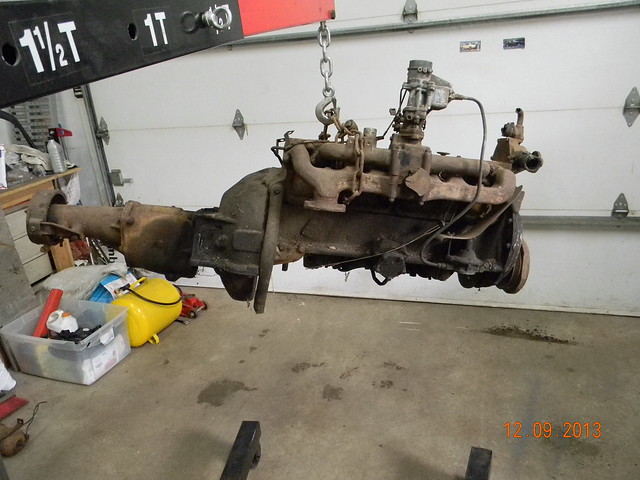
Buy another scrap engine. 
Bought it for scrap value, mostly for the accessories on it. It's a 1935 Plymouth flathead 6, which is supposed to be an evolution of the four-banger I have. I guess I'll use whichever engine I can rebuilt.
Lots of engine pictures please. These are pretty cool.
Back in the day there were a fair number of speed parts sold for the flathead six...Chryco used it for a loooong time in pretty much everything up until the mid-50's. Think the Power Wagon came with it for another ten years or so after that.
Wikipedia says the flathead 6 was used industrially into the 70s, so stock rebuild parts should be everywhere if you know where to go.

fanfoy
HalfDork
9/12/13 8:33 p.m.
So for you vintage engine dorks, here are a few more pictures. First the 1930 four-banger. It's a really simple engine.
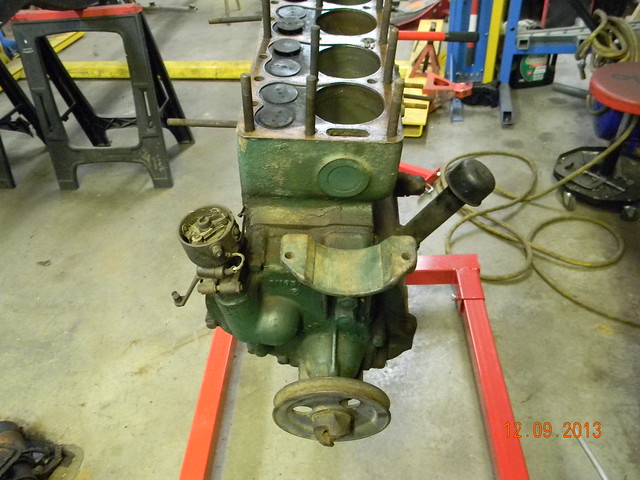 At the front, notice that the only accessory is the generator that sits in that cradle on top. Notice also the little arm on the side of the dizzy. That's for manually adjusting the advance (cable attaches to it). And notice the nut that holds the main pulley. It's designed for a hand crank.
At the front, notice that the only accessory is the generator that sits in that cradle on top. Notice also the little arm on the side of the dizzy. That's for manually adjusting the advance (cable attaches to it). And notice the nut that holds the main pulley. It's designed for a hand crank.
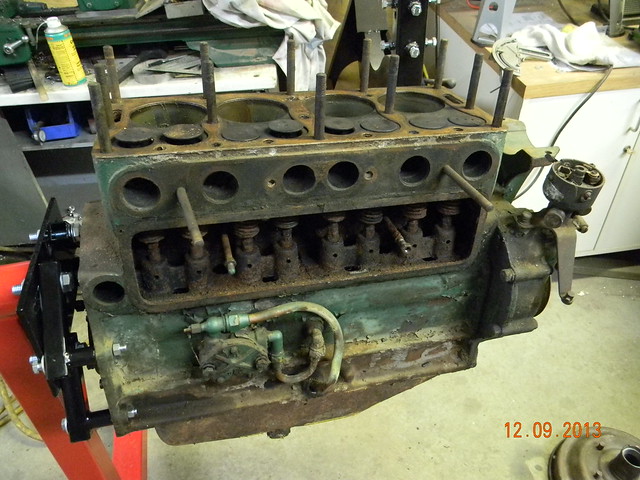 On the right side, we have the oil pump, the valvetrain and the intake and exhaust ports.
On the right side, we have the oil pump, the valvetrain and the intake and exhaust ports.
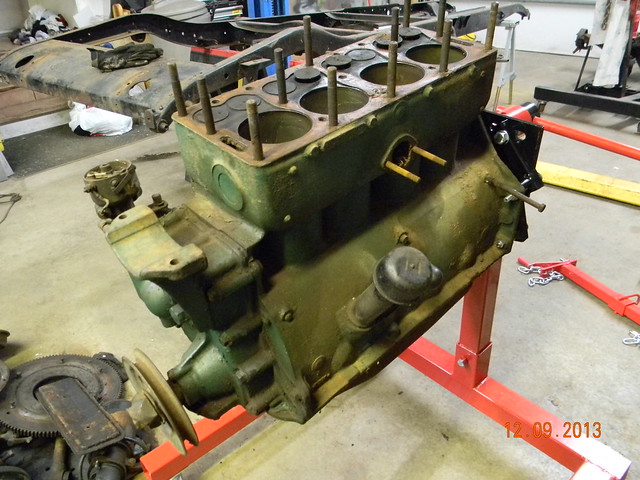 And on the other side, notice the shape of the water jacket.
And on the other side, notice the shape of the water jacket.
It's a nice simple engine but certain specific parts are hard to find.
I'll post pictures of the inline six in another post. Compared to the four-banger, the flathead six is common and easy to find, so I might just go that route.
Thanks for that. I find these old engines fascinating. I have an urge to collect them just to look at them.

The 1935 flathead six is a lot more "modern" by comparison. It has luxuries like a water pump, vacuum advance, a mechanical fuel pump and a starting solenoid (as opposed to the starting pedal on the 1930).
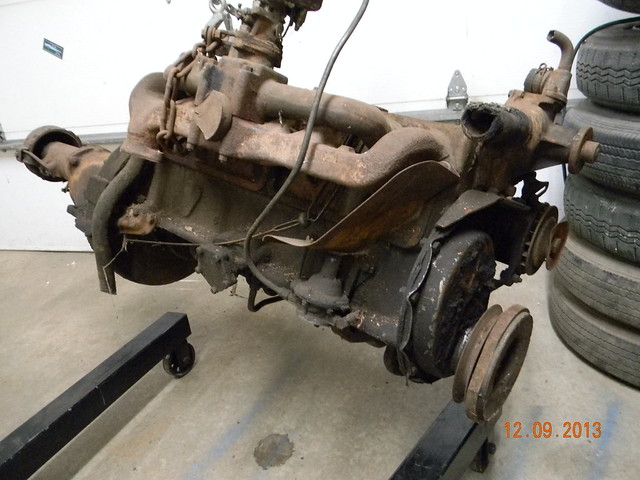 On the right side of the engine, you can see the fuel and the oil pumps. Notice also that the intake and exhaust manifold are connected to allow the intake air to be warmed. That is to help the fuel to vaporize. And the pipe that goes no where at the back of the block (hard to see) is the crankcase vent. It dumps the excess oil straight on the ground.
On the right side of the engine, you can see the fuel and the oil pumps. Notice also that the intake and exhaust manifold are connected to allow the intake air to be warmed. That is to help the fuel to vaporize. And the pipe that goes no where at the back of the block (hard to see) is the crankcase vent. It dumps the excess oil straight on the ground.
 Notice the band on the tail of the transmission. It's the handbrake. Because Mopars were among the first to use hydraulic brakes, they didn't know how to integrate the parking brake inside the drums, so they used this band brake on the transmission.
Notice the band on the tail of the transmission. It's the handbrake. Because Mopars were among the first to use hydraulic brakes, they didn't know how to integrate the parking brake inside the drums, so they used this band brake on the transmission.
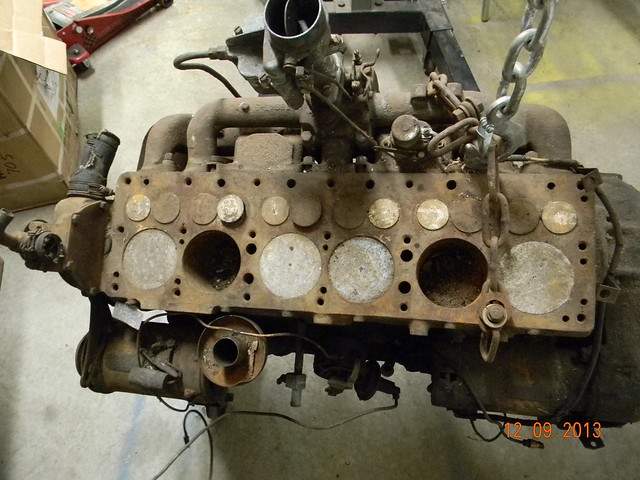 And this is the reason, why I'm not sure I'll use this engine. The bores are pretty rusted, and it's missing the oil pan, and head.
And this is the reason, why I'm not sure I'll use this engine. The bores are pretty rusted, and it's missing the oil pan, and head.
Finally, this car is the inspiration for this build. It's based on a 1929 Chrysler and uses the flathead six. The frame is a little too lowered for my taste, but for the most part, I love that. Search "1929 chrysler speedster" for more pictures.
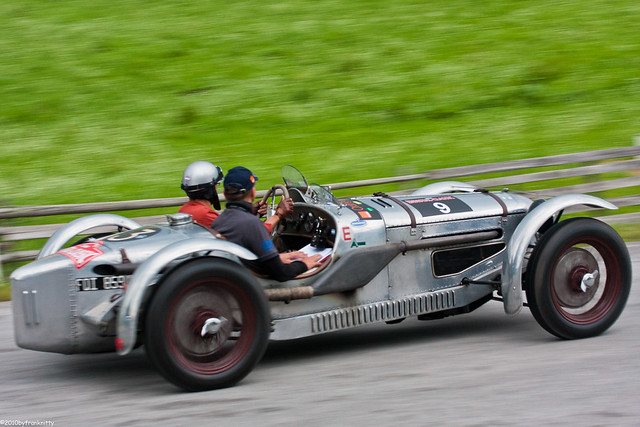
Those are some big ass drums.
I doubt that sourcing a head, oil pan, and oversized pistons for an engine built for over 40 years will be hard.
I have a rebuilt 1939 Plymouth with new valve seats and pistons. Also, I have a whole core with trans, a P-8 trans with floor shift and a pile of other parts. I guarantee you can't rebuild yours for the price you can buy all this stuff for.

RossD
PowerDork
9/13/13 7:26 a.m.
JoeyM wrote:
my new favorite thread
Get out of my head!
Re fanfoy:
I love this. Please don't stop working on this project. If you do stop working on it, heaven forbid, at least keep taking pictures of the engines and posting them here!

fanfoy
HalfDork
9/13/13 7:57 a.m.
Re Kenny_McCormic:
Yeah the parts are pretty easy to source. Heck, there are even a few places that make performance parts for them. Probably expensive, but pretty.
Re JoeyM:
Right back at you. Love your build thread.
Re wheels777:
You have mail.
Re RossD:
There should be tons of pictures to come.

tuna55
PowerDork
9/13/13 7:57 a.m.
Yes, please finish this one to scratch my itch!
fanfoy wrote:
parts are pretty easy to source. Heck, there are even a few places that make performance parts for them. Probably expensive, but pretty.
how awesome that a guy is able to carve out such a specific niche. I love stuff like this!
Need a pair of badass headlights?


fanfoy
HalfDork
9/19/13 12:55 p.m.
So time for a little update.
I focused on stripping the frame from all the little brackets it had, as well as the two middle cross-members.
Before
 After, with all the stuff in the pile on the left
After, with all the stuff in the pile on the left
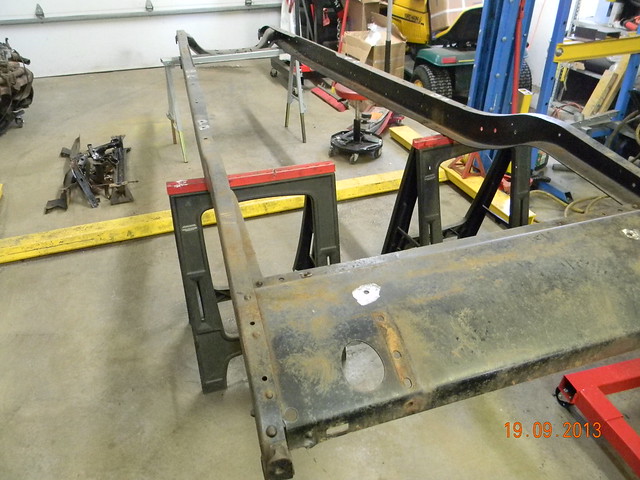
That's one of those jobs that are a lot harder than they look, and by the time you're done, it looks like you did almost nothing. Everything on the frame is riveted with huge solid rivets. I took out about 30 rivets, and they all fought me.
Everything on the frame is riveted with huge solid rivets. I took out about 30 rivets, and they all fought me.
With that done, I quickly mocked-up the frame with the engine, and axles in place. This is with the axles on their bump-stops to see how low I can set the engine, and seats between the rails, without them hitting the road in full compression. The frame will end up about 4-5 inches higher at ride height.
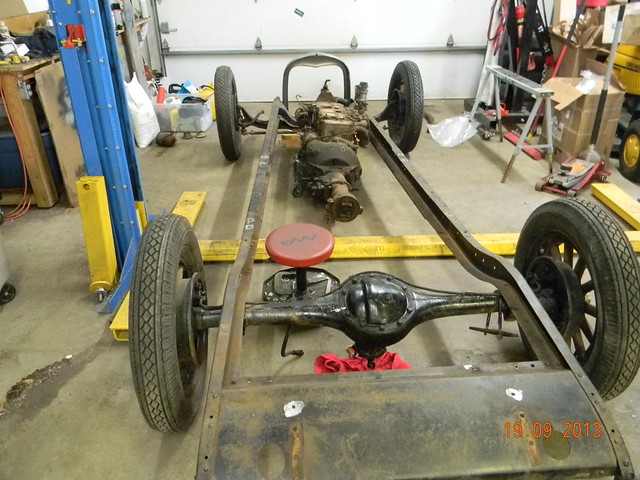
Also, got myself a Ford Model A radiator shell which I intend to modify to give it another look. I'm thinking of adding a vertical bar in the middle, and veeing the front face of it.
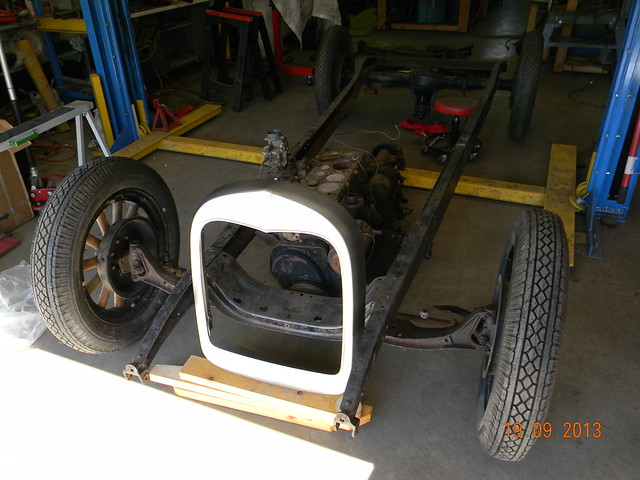
Great start watching this one closely.....
















 At the front, notice that the only accessory is the generator that sits in that cradle on top. Notice also the little arm on the side of the dizzy. That's for manually adjusting the advance (cable attaches to it). And notice the nut that holds the main pulley. It's designed for a hand crank.
At the front, notice that the only accessory is the generator that sits in that cradle on top. Notice also the little arm on the side of the dizzy. That's for manually adjusting the advance (cable attaches to it). And notice the nut that holds the main pulley. It's designed for a hand crank.
 On the right side, we have the oil pump, the valvetrain and the intake and exhaust ports.
On the right side, we have the oil pump, the valvetrain and the intake and exhaust ports.
 And on the other side, notice the shape of the water jacket.
And on the other side, notice the shape of the water jacket. On the right side of the engine, you can see the fuel and the oil pumps. Notice also that the intake and exhaust manifold are connected to allow the intake air to be warmed. That is to help the fuel to vaporize. And the pipe that goes no where at the back of the block (hard to see) is the crankcase vent. It dumps the excess oil straight on the ground.
On the right side of the engine, you can see the fuel and the oil pumps. Notice also that the intake and exhaust manifold are connected to allow the intake air to be warmed. That is to help the fuel to vaporize. And the pipe that goes no where at the back of the block (hard to see) is the crankcase vent. It dumps the excess oil straight on the ground.
 Notice the band on the tail of the transmission. It's the handbrake. Because Mopars were among the first to use hydraulic brakes, they didn't know how to integrate the parking brake inside the drums, so they used this band brake on the transmission.
Notice the band on the tail of the transmission. It's the handbrake. Because Mopars were among the first to use hydraulic brakes, they didn't know how to integrate the parking brake inside the drums, so they used this band brake on the transmission.
 And this is the reason, why I'm not sure I'll use this engine. The bores are pretty rusted, and it's missing the oil pan, and head.
And this is the reason, why I'm not sure I'll use this engine. The bores are pretty rusted, and it's missing the oil pan, and head. 






 After, with all the stuff in the pile on the left
After, with all the stuff in the pile on the left

























